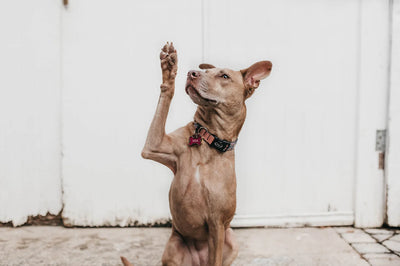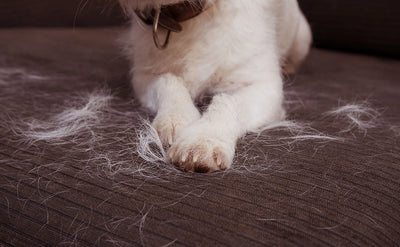Separation anxiety in dogs and pandemic puppies is on the rise as workers transition back to the office. We look at how to spot separation anxiety in dogs and what you can do to help your woofer settle when they’re home alone.

Whether you’ve recently got a puppy (yay!) and you’re leaving them home alone for the first time, or you’ve got a doggo who’s adapted to you working from home and you’re beginning to transition back to the office, it can be hard to leave your hound at home for long hours. Add separation anxiety into the mix and you’ve got a recipe for disaster. If you’re not sure how to help a dog with separation anxiety, we’ve got you covered.
We’re going to deep dive into the signs and symptoms of separation anxiety in dogs and how to help a dog with separation anxiety.
Does your dog have separation anxiety?
Before we jump into the solutions to separation anxiety in dogs, you need to work out if your woofer is suffering from it.
Separation anxiety in dogs describes the distress your dog experiences when they’re separated from you (or their other best mates). Separation anxiety in dogs is more than puppy-dog-eyes on your way out the door – it shows itself in a myriad of ways – but the common theme is a distressed doggo.
Being home alone is ruff, but not knowing when your bestie is coming back can make it unbearable. Your woofer doesn’t speak English, so when you leave the house they aren’t sure if you’re coming back. That’s where dog separation anxiety training comes in.
Signs and symptoms of separation anxiety
Symptoms of separation anxiety in dogs are excessive barking and howling, urinating and defecating in your home, chewing, digging, pacing and escape attempts.
If your pupper is experiencing any of these symptoms, think about the surrounding circumstances. If they’re doing their business inside the house, consider if they’re properly toilet trained. Do they hold their bladder normally when you’re at home or are you constantly monitoring them, waiting to pounce?
Do they normally chew up the couch when you’re working from home? If they do, chewing it up in your absence may not be abnormal (although some treats and toys are a good idea to redirect chompers from the couch in the future). The same goes for digging, pacing and escape attempts. Separation anxiety in dogs describes out-of-the-ordinary behaviour that indicates your dog is in distress.
When making a judgment about whether your dog is suffering from separation anxiety, trust your gut. You know your dog best.
If your pupper is experiencing any of these symptoms, think about the surrounding circumstances. If they’re doing their business inside the house, consider if they’re properly toilet trained. Do they hold their bladder normally when you’re at home or are you constantly monitoring them, waiting to pounce?
Do they normally chew up the couch when you’re working from home? If they do, chewing it up in your absence may not be abnormal (although some treats and toys are a good idea to redirect chompers from the couch in the future). The same goes for digging, pacing and escape attempts. Separation anxiety in dogs describes out-of-the-ordinary behaviour that indicates your dog is in distress.
When making a judgment about whether your dog is suffering from separation anxiety, trust your gut. You know your dog best.
How to help a dog with separation anxiety
Separation anxiety in dogs can feel difficult to overcome, but it isn’t impossible. With some dog separation anxiety training, your woofer will be cool, calm and collected when they’re home alone in no time.
Start small
As is often the case with any dog training, starting small is a good idea. When it comes to dog separation anxiety training, don’t bite off more than you or your dog can chew. If you have worked from home consistently and haven’t left your dog alone for long, start by picking up your keys, putting on your shoes and leaving for a few minutes. This ritual gets them familiar with you leaving the house. It normalises your morning routine and your hound begins to understand that you aren’t leaving forever, and that you’re always coming back.
As your dog separation anxiety training progresses, start increasing the amount of time you leave the house for until you’re able to leave for hours at a time.
As your dog separation anxiety training progresses, start increasing the amount of time you leave the house for until you’re able to leave for hours at a time.
Good things come to those who stay home alone
Dogs are pretty easily pleased, and although they love you a lot, they tend to forget this when there’s a treat to sniff out or a toy to find. Make being home alone a fun experience for your pup, especially when you’re doing it for the first time. Put chewy chicken strips in their bed or hide bite-sized treats around the house.
Create a safe space
Separation anxiety in dogs often stems from your doggo not feeling safe without you. Dogs are like hoomans, they need a safe space where they can feel at home. When your dog is feeling overwhelmed or stressed, the familiarity of a safe space brings comfort.
Creating a safe space is key to dog separation anxiety training. Your dog’s place might be their bed or crate (if you’ve crate trained them); whatever it is, practice using safe space when you’re at home. Put them in their bed or crate in the next room. This way, they get used to being by themselves but can still hear you moving around the house.
Safe spaces are all about creating a sense of normalcy for your pup. Playing music that mimics the sounds of you being at home helps fill the silence your absence creates. You can also leave your floof with some clothing that smells like you so you don’t feel too far away.
Creating a safe space is key to dog separation anxiety training. Your dog’s place might be their bed or crate (if you’ve crate trained them); whatever it is, practice using safe space when you’re at home. Put them in their bed or crate in the next room. This way, they get used to being by themselves but can still hear you moving around the house.
Safe spaces are all about creating a sense of normalcy for your pup. Playing music that mimics the sounds of you being at home helps fill the silence your absence creates. You can also leave your floof with some clothing that smells like you so you don’t feel too far away.
Boredom is the enemy
If you’re still not sure how to help a dog with separation anxiety, try boredom busting. Giving your floofer something to do while you’re out and about is key to dog separation anxiety training. It’s the difference between you coming home to cuddles, or a chewed up couch. Try giving them a new toy as you leave the house, hide treats around the house for a tasty treasure hunt or put a dental treat inside a cardboard box on your way out the door.
Stimulating their mind keeps their worries at bay. Before they even know it, you’ll be back home and ready for cuddles.
A tired woofer is a good woofer
A big part of dog separation anxiety training happens before you leave the house. To stop your four-legged friend from going stir crazy when you leave the house, tire them out before you leave. Take them for a long morning walk or hire a walker to visit them at lunchtime.
Just like hoomans, exercise and mental stimulation tires your dog out and makes them less likely to stress while you’re away – and more likely to snooze.
Avoid punishments
Whatever you do, don’t scold your hound when you come home to find they’ve dug up the backyard or chewed on the kitchen cupboards. They’ve long forgotten their behaviour, their actions were a stress response, and they will associate any scolding with being left alone. Essentially, you’re going to make the problem worse by telling them off.
Make coming home a calm occasion, come in calmly and quietly and wait until your furry friend is sitting calmly before you give them cuddles. If you create too much fanfare when you come home, your woofer will get worked up waiting for you.
Make coming home a calm occasion, come in calmly and quietly and wait until your furry friend is sitting calmly before you give them cuddles. If you create too much fanfare when you come home, your woofer will get worked up waiting for you.
See a specialist
If you’ve tried these dog separation anxiety training tips and your hound is still terrified or agitated when you leave the house, consider seeking out specialist help.
Even if you’re certain your dog is suffering from separation anxiety, it’s a good idea to make an appointment with your veterinarian to rule out any potential health problems.
Even if you’re certain your dog is suffering from separation anxiety, it’s a good idea to make an appointment with your veterinarian to rule out any potential health problems.
Thanks furr-reading! We hope these steps have helped your canine conquer their fears. If you’re in need of a little extra help, try our boredom busters – we’ve got like tasty treats for treasure hunts, toys that go the extra mile and dental chews that keep your woofer’s chompers busy.



